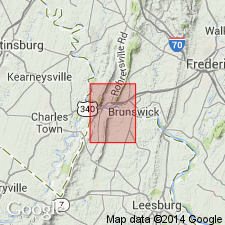
- Usage in publication:
-
- Fort Duncan Member
- Modifications:
-
- Named
- Dominant lithology:
-
- Dolomite
- AAPG geologic province:
-
- Appalachian basin
Summary:
Named the Fort Duncan Member of the Tomstown Formation for Fort Duncan, along Potomac River (west of Harpers Ferry, WV), Washington Co., MD. Unit extends from the Harpers Ferry, WV area northward to southern PA. Consists of dark-gray, medium- to thick-bedded, bioturbated dolomite. Thickness is 175 to 200 feet. Overlies the Bolivar Heights Member and underlies the Benevola Member, both of the Tomstown Formation. Lower contact is placed beneath dolomite bed overlying bioturbated limestone of the Bolivar Heights. Upper contact is placed within a 15-foot gradational zone with the overlying Benevola Member. The Fort Duncan is of Early Cambrian age.
Source: GNU records (USGS DDS-6; Reston GNULEX).

- Usage in publication:
-
- Fort Duncan Member*
- Modifications:
-
- Areal extent
- AAPG geologic province:
-
- Appalachian basin
Summary:
Geographically extended the Fort Duncan Member of the Tomstown Formation into northern VA. In VA, WV, and MD, the Fort Duncan consists of medium dark-gray to grayish-black, medium-bedded, pervasively bioturbated dolomite with very light-gray to white sparry dolomite void-fillings. Thickness is 80 meters. Overlies the Bolivar Heights Member and underlies the Benevola Member, both of the Tomstown Formation.
Source: GNU records (USGS DDS-6; Reston GNULEX).
For more information, please contact Nancy Stamm, Geologic Names Committee Secretary.
Asterisk (*) indicates published by U.S. Geological Survey authors.
"No current usage" (†) implies that a name has been abandoned or has fallen into disuse. Former usage and, if known, replacement name given in parentheses ( ).
Slash (/) indicates name conflicts with nomenclatural guidelines (CSN, 1933; ACSN, 1961, 1970; NACSN, 1983, 2005, 2021). May be explained within brackets ([ ]).

